The little-known corner of Europe that combines thrills with fine wine
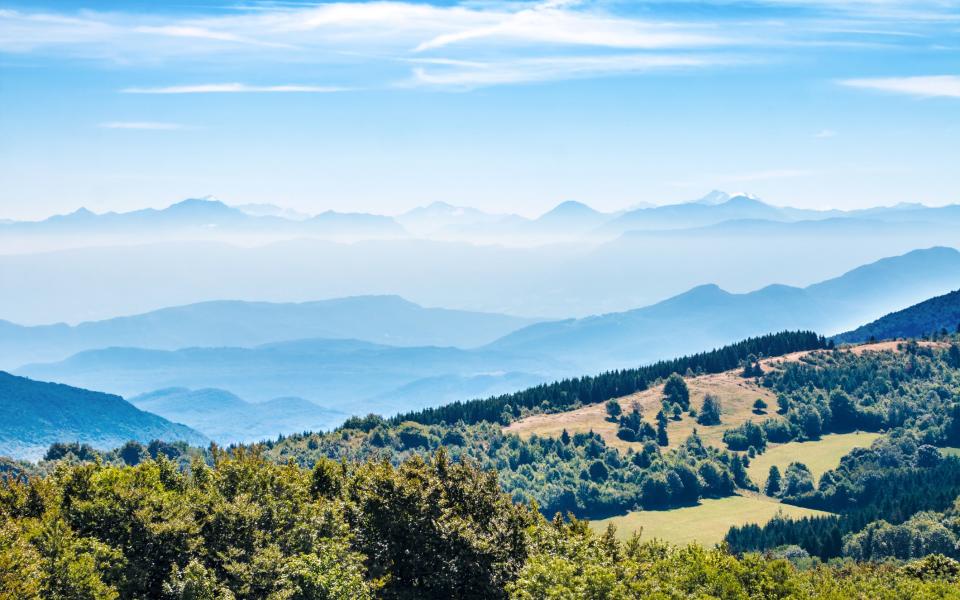
No, I said. I don’t want a holiday in the cold. I haven’t skied since I was 17. It’s expensive. And there’s nothing decent to drink except hot chocolate. But, said my partner, Craig, the children love winter sports. And as for nothing to drink… I have an idea.
This is how we ended up in the Jura. This mountain range on the border between France and Switzerland is just two hours’ drive from Geneva, or less than three from Lyon, and while the latter is famous as a gastronomic destination the Jura isn’t terribly well known for anything. Yet this is the home of Comté, Morbier and Mont d’Or cheese, has delicatessens where the perfume of cured meat hits you when you walk in the door, and is becoming known as a region making lovely wine from indigenous grapes – the light, cherry-ish reds, Poulsard and Trousseau – and from the better-known Pinot Noir and Chardonnay.
There is also the delicious Vin Jaune, a style of wine made only here, from the local Savagnin grape. I’d always wanted to come and taste these wines in situ, as Craig well knew. I just hadn’t planned for his four children, none of whom has any interest whatsoever in wine, to accompany us. But above the vine-carpeted lowlands there’s snow, and while the highest peak is just 1720 metres – much lower than the Alps - there is snow during February half-term, and an amazing range of child-friendly activities, from downhill to cross-country skiing, snowboarding or snowshoeing. There is also hiking, which the children, aged between 9 and 16, dislike almost as much as vineyard visits.
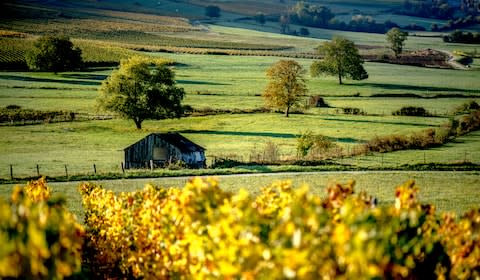
We’ll need snow tyres, said Craig, as we negotiated with Sixt for a car big enough for six. I rolled my eyes and muttered about snowbound drama queens, then had to retract everything when we ended up on an icebound overpass on our drive from Lyon. We arrived to a fresh fall of snow and managed three days of skiing before the weather failed us or anyone mutinied.
My hazy memories of skiing involve endless queues for ski-lifts and long, chilly journeys back to basic accommodation. The Jura is very different. Our 16-suite hotel, Les Rives Sauvages, in Malbuisson, was lakeside with fabulous views and a spa, just 10 minutes’ drive from the resort of Métabief.
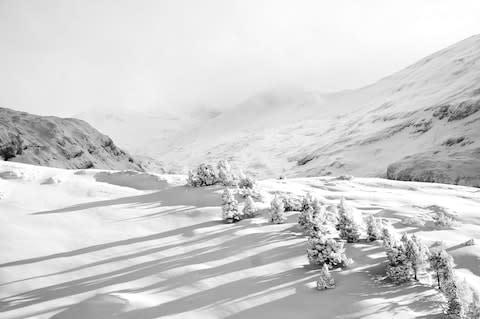
Thierry and his staff at Métaski quietly and capably found us the kit we needed and stored it for us between sessions on the slopes; the shop’s location meant we could ski to the door. Even the resort supermarket was reasonably priced. And there were no queues for the ski-lifts. The Jura, unlike the Alps, is not a renowned skiing destination. It is cheaper and friendlier, and if the runs are fewer and the snow less deep, the skiing is still terrific, with incredible views down to the lowlands full of wineries I was trying hard not to think about.
The sun shone; the snow sparkled. And I grew grumpier and grumpier. I couldn’t even buy great wine, much less organise a tasting: the best wine shops would be near the vineyards. Just an hour down the hill… and here I was, stuck in an admittedly excellent ski resort.
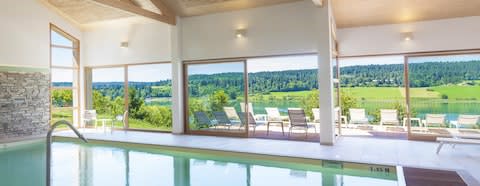
Then the weather helped me out: it rained. Cosy in our nine-seater van, snow tyres and all, we drove south along the mountain-tops, parallel with the Swiss border, a scenic if scary 90-minute drive south-west, to La Pesse. This was the wrong direction for my purposes – I wanted to head west, to Arbois, wine capital of the Jura – but nonetheless, I felt optimistic. We wanted to try tobogganing – the Jura is proud of its year-round toboggan runs, claiming to have the longest in Europe and slopes with a gradient of up to 37 per cent. There is tobogganing at Col de la Faucille, a mountain pass used by the Tour de France, and at Mijoux, where the slope is lit up at night until 9.30pm (weekends only outside school holidays). But we were distracted in the shop by snow-tubing: overgrown inflatable rings, like posh tyres (“it actually was tyres when I was a kid,” muttered Craig, who is Canadian). Each whooping child (or, ahem, adult) whirled in turn down a slide carved out of the snow: not fast enough, was the verdict from Reuben, age 16, but everybody else enjoyed themselves despite the tedious ascent, hauling the tubes back to the top of the slope.
At last, said the children: lunch. At last, muttered the adults: wine. At L’Auberge des Érables we tried a fondue – a melted pool of the local Comté, served over a portable stove – matched with a pleasant, cherry-ish Poulsard (a local red grape). It was a welcome opportunity to expand my knowledge of Jura wines, if with some restraint, since the afternoon’s activity was dog-sledding. Part of the Jura Mountains Regional Natural Park is exclusively reserved for dog-related activities: you can ski with dogs, sled with dogs, or learn to be a musher – master of the dog-sled – yourself.

Two full teams of huskies pranced and panted in the traces as we glided through the park, dog’s-height from the ground. It was magical, the only sound the shushing of runners in snow, the pant and yelp of the dogs and the shouts and whistles with which our mushers, two sturdy young women seemingly unperturbed by the drizzle, coaxed the dogs to do their bidding.
The Jura maintains its tradition of truly superb food. I suspect this is partly thanks to its relative remoteness: the hypermarkets that are sucking the gastronomic life out of much of France haven’t got the critical mass here, and so butcher shops and local markets can still make a living. The excellent wines don’t hurt either: people who love wine tend to love good food, and there are excellent restaurants dotted all over the Jura, at every price point from fondue joints up to Michelin-starred temples. There is also the region’s ancient status as a purveyor of salt. We visited the salt factory at Arc-et-Senans, an imposing complex that’s now a museum. What resonated with our lot was the salty water in the pool at Salins-les-Bains thermal baths. This was the response, in the late 19th century, to the end of the area’s salt trade with Switzerland, and apparently it was very successful.
The next day, the weather improved but it was my turn to mutiny. I want to visit vineyards, I said. “Wine-tasting again?” said Reuben, wearily. He was desperate to try the Biathlon, an amazing sport where you ski cross-country to a range, air rifle on your back, stopping periodically to shoot at targets. A competition on the slopes put paid to that idea, but I had more luck. I dropped them all at the slopes then ran away to the lowlands, leaving Craig with his progeny and promises of compensatory bottles on my return.

In fact, even these jaded children would have enjoyed the Pignier winery. Jean-Étienne Pignier has fabulously creepy 13th-century cellars with vaulted stone ceilings: the winery was church property until it was bought by his family in 1794, after the French Revolution, and there’s still a secret passage (blocked, sadly) between the cellars and the village church. A large block of stone is in fact an ancient saloir – the pre-electricity incarnation of a fridge, which would have been filled with salt to preserve food. The children enjoyed the wine-quiz booklets I brought home, which included word-search games, colouring-in and other such forms of subtle propaganda designed to give children an inkling of the excitements to come – and enable their parents to taste Pignier’s excellent wines in peace.
In the tiny village of Montigny-lès-Arsures I visited Domaine André et Mireille Tissot, where Bénédicte and Stéphane (the next generation) make a Jura specialty: Vin Jaune, wine from the local white grape, Savagnin, aged in barrel under a covering of naturally occurring yeast known here as a voile, or veil. It’s a similar process to sherry and, in fact, the wines have a sherry tang to them, as well as a delicious nuttiness. Stéphane’s winery isn’t set up for tourism but he has a dedicated shop in Arbois, the picturesque village where Louis Pasteur experimented with pasteurisation and fermentation at his riverside house (now a museum) and in his vineyards nearby.
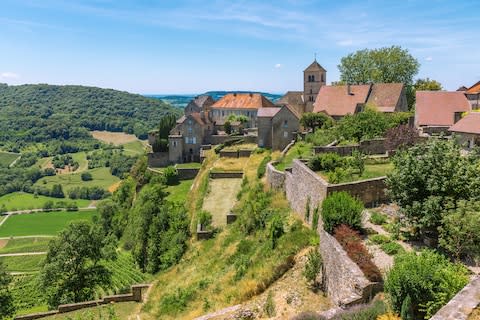
We passed through Arbois several times, partly because of Aux Délices du Palais, a superb butcher and deli and partly because I wanted to visit Les Jardins de St Vincent, a much-recommended wine shop that remained stubbornly shut no matter what day or time I visited.
Our last day, even I wanted to ski, to stop for a crêpe at Le Flocon, a great café on the slopes, and to take advantage of the hotel spa one last time. Technically, children aren’t allowed to use the pool after 5pm but the hotel wasn’t full and the kind receptionist let us all go in late – fortunately, since otherwise our skiing timetable would have prevented us going in at all. The steam room and sauna were for 16 years and over but everyone enjoyed the little room set aside for relaxation and tea-drinking – as well as for the swan-necked jets that poured high-pressure water into the pool.
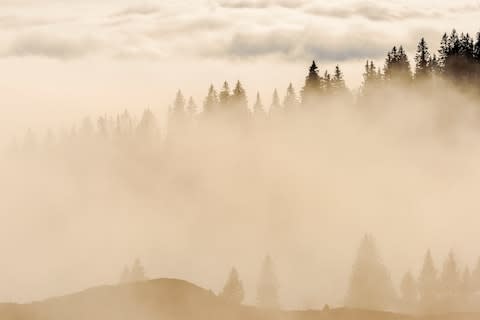
We were having a lovely time, but Craig was still shooting me pitiful looks, probably because he wanted to come wine-tasting, too. I had tried to pacify him on my day of truanting by buying wines from Tissot and Pignier and stopping at an excellent wine shop that was actually open: Essencia, in Poligny. And we had drunk incredibly well. But despite the Pinot Noir by Ganevat, the Chardonnay from Michel Gahier and several excellent Crémants (sparkling wines) including BBR, Tissot’s fabulous barrel-fermented 100 per cent Chardonnay fizz, he wasn’t satisfied.
So on our penultimate night we let the children loose on the suite’s two gigantic screens – bliss for four addicts cruelly deprived of televisions in both their homes – and went for a fabulous, if less than leisurely, dinner at a Michelin-starred restaurant usefully situated a five-minute stroll from our hotel. Le Bon Accueil has an old-fashioned ethos (Marc Faivre cooks, his wife Catherine is front of house) and a marvellous cellar: “You could be snowed in there for weeks and you wouldn’t go thirsty,” Jean-Étienne Pignier had assured me.
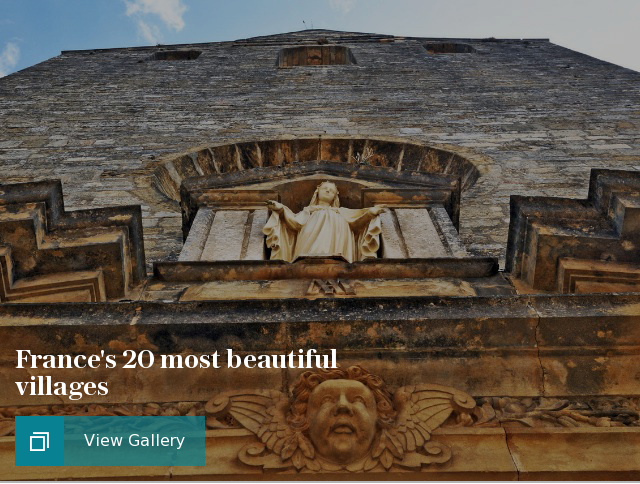
As we drove home the next day, our multiple wine purchases nicely padded by ski clothing, we congratulated ourselves on having found the holy grail in this unjustly neglected region: sport and spa, good food and fine wine, a little history and a lot of fun. Everybody wants to ski and dog-sled again; the children also demand a return trip in summer to sleep in a treehouse and water-ski on the lake. I want to get into that infuriating wine shop in Arbois. And Craig? He just wants to go wine-tasting.
How to do it
Sixt has cars and vans with snow tyres at their outlets in Lyon and Dijon; make sure to request them as an essential, or you may get a car without.
Les Rives Sauvages is a 16-suite hotel on Lake Saint-Point, with spa. Suite for six, including kitchen-dining area, from €120 (£105).
Le Bon Accueil is a marvellous restaurant with terrific local wine list in Malbuisson, so modest they don’t even mention their Michelin star.
The best family activities
Skiing in Métabief is easy, friendly and cheaper than elsewhere: child ski-passes from €22.50 (£20) per day, adults from €26.50 (£23.50). Metaski has all the necessary equipment.
Dog-sledding is horribly expensive – an hour is €63 (£55) for an adult, €45 (£40) for children under 12 – but absolutely brilliant, with a full team of dogs and a chance to pet them beforehand. Other dog-related activities available, too.
Fondue: The Jura is the home of Comté, Mont d’Or and Morbier cheeses, of good bread and Hirsinger’s fabulous chocolate shop and, of course, great wine. For children, though, nothing beats fondue: a gargantuan quantity of Comté melted with garlic, nutmeg and local white wine, with chunks of bread speared on sticks and dunked directly in the pot. Plenty of places offer this (and you can make it yourself) but our outing to L’Auberge des Érables in La Pesse was a huge success.
Travel tips
Check Parisian school holidays before you book, as resorts and slopes are calmer and in some cases, cheaper, when French families aren’t using them.
You need a vignette sticker if using Swiss motorways. Bear this in mind if driving across the border, although Swiss rental cars have them already.

